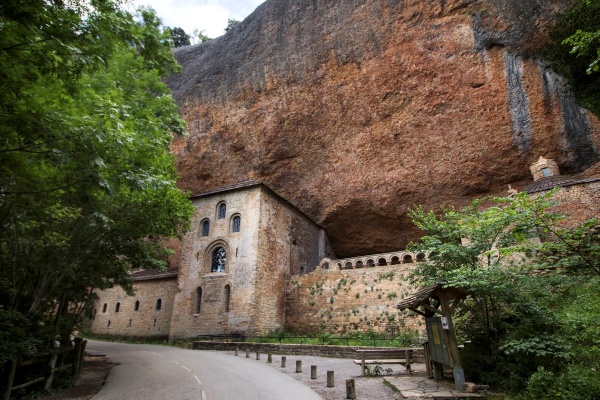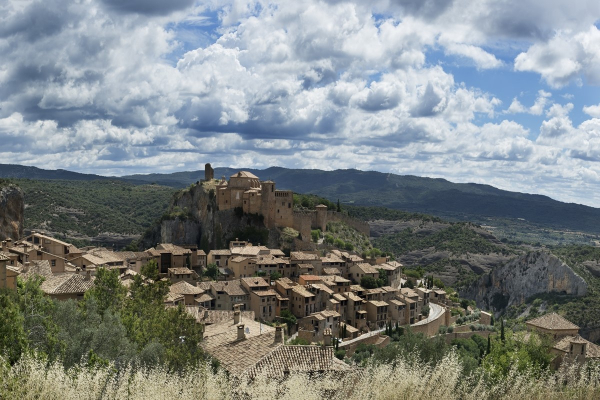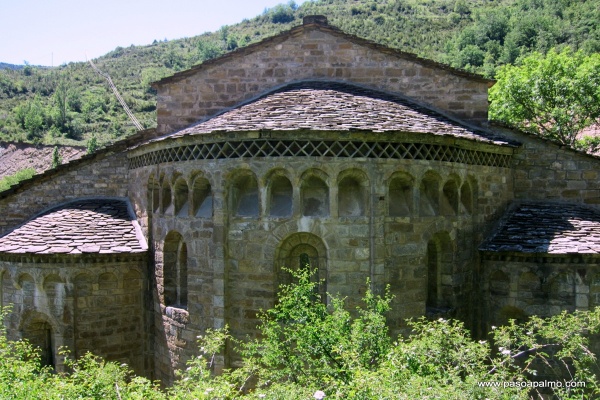Valleys and Peoples with Centuries of History
Your trip to the Pyrenees would not be complete without visiting some of the charming and remote villages of the region and experiencing the true Spanish culture and traditions therein. The inhabitants of these places have had to battle the elements in a sometimes hostile environment and developed sustainable traditional livestock and agricultural methods. A stroll down the idyllic streets of these villages will expose to you their storied pasts as you admire their architecture, castles, churches, and houses.
Explore some of the most spectacular UNESCO Heritage Sites in Spain such as the San Juan de la Peña Monastery, Citadel of Jaca, the Boí Taüll Chapel, the Collegiate Church of Alquezar, Roda de Isábena Cathedral, and Santa María de Obarra Monastery. All of these beautiful and historical places await showing you the real heart of Spain.

San Juan de la Peña Monastery
San Juan de la Peña Monastery is set amidst protected natural parkland and is one of the most stunning sacred buildings in the Aragonese Pyrenees, if not in all of Spain. It is a jewel from medieval times that was built right into the rocks of Mont Oroel. The remains of the monastery are just a small relic of the original structure, yet they still stand as an awe-inspiring testimony to their former glory from an age long passed. Of particular interest are the notable examples of Romanesque period architecture, paintings, and especially sculptures from the 11-13th centuries.
San Juan de la Peña is an historical-artistic complex. In 1675, a fire in the monastery forced the monks to flee and subsequently build a newer structure further up the hill. The Monasterio Nuevo features a helpful Visitors’ Centre and two interpretation centres which chronicle the history of the monastery and the eventful lives of the kings and queens of Aragón.

San Juan de la Peña Monastery
San Juan de la Peña Monastery is set amidst protected natural parkland and is one of the most stunning sacred buildings in the Aragonese Pyrenees, if not in all of Spain. It is a jewel from medieval times that was built right into the rocks of Mont Oroel. The remains of the monastery are just a small relic of the original structure, yet they still stand as an awe-inspiring testimony to their former glory from an age long passed. Of particular interest are the notable examples of Romanesque period architecture, paintings, and especially sculptures from the 11-13th centuries.
San Juan de la Peña is an historical-artistic complex. In 1675, a fire in the monastery forced the monks to flee and subsequently build a newer structure further up the hill. The Monasterio Nuevo features a helpful Visitors’ Centre and two interpretation centres which chronicle the history of the monastery and the eventful lives of the kings and queens of Aragón.
Citadel of Jaca
The Citadel of Jaca, or San Pedro’s Castle, is situated in the biggest city of the Aragonese Pyrenees. Its star-shaped footprint and its prominent location at the city centre has made it an icon of the La Jacetania region. Constructed in the last years of the 16th century under the order of Felipe II, it was built to defend this strategic city against the French invasion from the Tena Valley. At that time, Antonio Perez, former secretary of the king, was the captain of the Spanish army.


Citadel of Jaca
The Citadel of Jaca, or San Pedro’s Castle, is situated in the biggest city of the Aragonese Pyrenees. Its star-shaped footprint and its prominent location at the city centre has made it an icon of the La Jacetania region. Constructed in the last years of the 16th century under the order of Felipe II, it was built to defend this strategic city against the French invasion from the Tena Valley. At that time, Antonio Perez, former secretary of the king, was the captain of the Spanish army.

Boí Taüll Chapels
Vall de Boí’s Romanesque ensemble is made up of the churches of Sant Climent and Santa Maria in Taüll, Sant Joan in Boí, Santa Eulàlia and Erill la Vall, Sant Feliu in Barruera, La Nativitat and Sant Quir Hermitage in Durro, Santa Maria in Cardet, and L’Assumpción in Cóll. One of the main characteristics of this ensemble is the common architectural style.
The churches were all built during the 11th and 12th centuries and followed a design imported from northern Italy–the Lombard Romanesque. This style is characterised by its functional buildings and skilled stonework, thin bell-towers, and the external decoration of rounded arcading and pilaster strips.
Interestingly, the murals within were formally used in the churches of Sant Climent and Santa Maria in Taüll and in Sant Joan in Boí. They are now housed at the National Museum of Catalan Art (MNAC) in Barcelona. Another noteworthy highlight is the carvings, such as the Descent in the church of Santa Eulàlia and Erill la Vall, which was produced by Erill’s Workshop.
.

Boí Taüll Chapels
Vall de Boí’s Romanesque ensemble is made up of the churches of Sant Climent and Santa Maria in Taüll, Sant Joan in Boí, Santa Eulàlia and Erill la Vall, Sant Feliu in Barruera, La Nativitat and Sant Quir Hermitage in Durro, Santa Maria in Cardet, and L’Assumpción in Cóll. One of the main characteristics of this ensemble is the common architectural style.
The churches were all built during the 11th and 12th centuries and followed a design imported from northern Italy–the Lombard Romanesque. This style is characterised by its functional buildings and skilled stonework, thin bell-towers, and the external decoration of rounded arcading and pilaster strips.
Interestingly, the murals within were formally used in the churches of Sant Climent and Santa Maria in Taüll and in Sant Joan in Boí. They are now housed at the National Museum of Catalan Art (MNAC) in Barcelona. Another noteworthy highlight is the carvings, such as the Descent in the church of Santa Eulàlia and Erill la Vall, which was produced by Erill’s Workshop.
.
Collegiate Church of Alquezar
The majestic Collegiate Church of Santa Maríala Mayor is perched on a rocky mass. From here, you can access and explore many hidden treasures. The complex was originally an Arab fortification commissioned by Jalaf ibn Rasid. It was built in the 9th century as a result of the struggles against the Carolingians who occupied the Sobrarbe kingdom at that time. Unfortunately, the architecture from this period was not preserved.
In 1604, after Barbastro was seized by King Sancho Ramirez, the fortress passed to Christian hands and became a military garrison, and a religious community was established. Various buildings were constructed for both military and defensive functions as well as religious purposes. The whole complex is surrounded by double wall battlements and is protected by several turrets. One of the turrets was later used by the Collegiate Church as a bell tower.


Collegiate Church of Alquezar
The majestic Collegiate Church of Santa Maríala Mayor is perched on a rocky mass. From here, you can access and explore many hidden treasures. The complex was originally an Arab fortification commissioned by Jalaf ibn Rasid. It was built in the 9th century as a result of the struggles against the Carolingians who occupied the Sobrarbe kingdom at that time. Unfortunately, the architecture from this period was not preserved.
In 1604, after Barbastro was seized by King Sancho Ramirez, the fortress passed to Christian hands and became a military garrison, and a religious community was established. Various buildings were constructed for both military and defensive functions as well as religious purposes. The whole complex is surrounded by double wall battlements and is protected by several turrets. One of the turrets was later used by the Collegiate Church as a bell tower.

Roda de Isábena Cathedral
Though the small town of Roda de Isábena is inhabited today with a mere fifty residents, it was an important part of Aragón history and home to the most important religious centre in Ribagorza, the cathedral of Roda.
A walk through this town is reminiscent of its medieval past. It is surrounded by walls and the many monumental gates within this fortification stand out. The stone that was used in the houses, on the narrow streets, and in the arched doorways throughout the town evoke a bygone era of greater glory.
The Cathedra is comprised of a basilica floor with three naves and was completed with a presbytery and three apses. The Romanesque-style cathedral is the product of years of intense construction that began in 1010 A.D.

Roda de Isábena Cathedral
Though the small town of Roda de Isábena is inhabited today with a mere fifty residents, it was an important part of Aragón history and home to the most important religious centre in Ribagorza, the cathedral of Roda.
A walk through this town is reminiscent of its medieval past. It is surrounded by walls and the many monumental gates within this fortification stand out. The stone that was used in the houses, on the narrow streets, and in the arched doorways throughout the town evoke a bygone era of greater glory.
The Cathedra is comprised of a basilica floor with three naves and was completed with a presbytery and three apses. The Romanesque-style cathedral is the product of years of intense construction that began in 1010 A.D.
Santa María de Obarra Monastery
Santa María de Obarra is a Romanesque monastery located in the pre-Pyrenees at the foot of the western end of the Sierra de Sis. It was built by Lombard masters in the first quarter of the 11th century on the banks of the Isábena River (Ribagorza). Obarra translates to “hole between rocks” in the Basque language, as it sits at the bottom of a valley, blocked by the gauge La Croqueta, where the monastery stands.
This preserved monastic set is dedicated to San Pablo and contains the ruins of an abbey palace and an old mill. The church dedicated to Santa María dates from the end of the 10th century to the first part of the 11th century. The buildings were built with untreated stones which gives them a rustic and strikingly unique appearance.


Santa María de Obarra Monastery
Santa María de Obarra is a Romanesque monastery located in the pre-Pyrenees at the foot of the western end of the Sierra de Sis. It was built by Lombard masters in the first quarter of the 11th century on the banks of the Isábena River (Ribagorza). Obarra translates to “hole between rocks” in the Basque language, as it sits at the bottom of a valley, blocked by the gauge La Croqueta, where the monastery stands.
This preserved monastic set is dedicated to San Pablo and contains the ruins of an abbey palace and an old mill. The church dedicated to Santa María dates from the end of the 10th century to the first part of the 11th century. The buildings were built with untreated stones which gives them a rustic and strikingly unique appearance.
